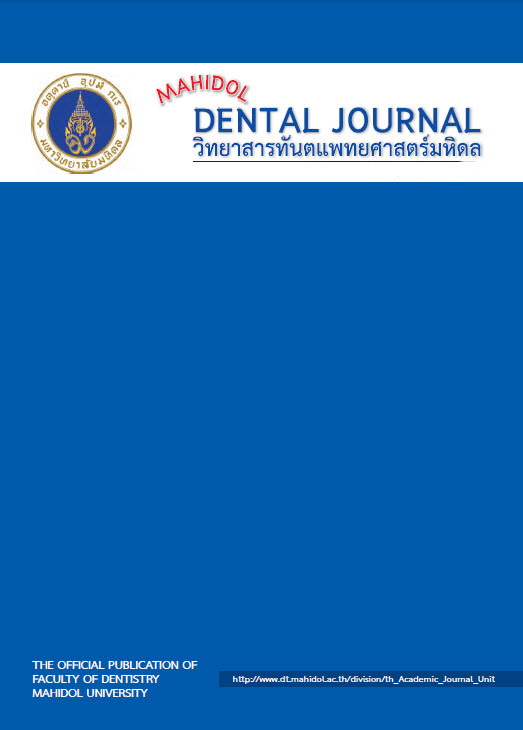Autoclave monitoring and packaging in Bangkok dental offices, Thailand
Main Article Content
Abstract
Objectives: To examine the regular practice of autoclave monitoring and autoclave dental packaging in Bangkok dental offices, Thailand.
Method and Materials: A preliminary questionnaire interview was performed in 52 private clinics in 2006 and a postal questionnaire was sent out to 629 hospital and private clinics in 2013. Questions included practices on 3 modes of sterilization monitoring: mechanical, chemical, and biological, as well as the types of packaging used.
Results: The response rate of the 2013 survey was 18% (n=113). We found improved formal education in infection control but understanding in the significance of autoclave performance monitoring was still low. Mechanical monitoring was performed the most (90.2%) compared with other types of monitoring. External and internal chemical monitoring were applied in 75% and 33% of all clinics, respectively. Biological monitoring was done in 17.9% of clinics surveyed. Only 2% performed all types of monitoring. The disposable paper/plastic pouch was the main packaging material (92.9%) for autoclave, among these 78.1% reused the pouch. Each paper/plastic pouch was reused most frequently 3 times before disposal. Hospital clinics performed better monitoring in all aspects and reused the pouch less than in private clinics.
Conclusion: Sterilization monitoring of an autoclave machine was inadequate among Bangkok dental offices and knowledge could be the contributing factor to poor practices as formal education was low. Reuse of a paper/plastic pouch was a routine practice but its impact was unknown. There is a need of better education on infection control and further study on the validity of pouch reuse.
Article Details
References
2. Oosthuysen J, Potgieter E, Fossey A. Compliance with infection prevention and control in oral health-care facilities: a global perspective. Int Dent J 2014; 64: 297-311.
3. AlNegrish A, Al Momani AS, Al Sharafat F. Compliance of Jordanian dentists with infection control strategies. Int Dent J 2008; 58: 231-236.
4. Acosta-Gio AE, Mata-Portuguez VH, Herrero-Farias A, Sanchez Perez L. Biologic monitoring of dental office sterilizers in Mexico. Am J Infect Control 2002; 30: 153-157.
5. van Doornmalen JP, Dankert J. A validation survey of 197 hospital steam sterilizers in The Netherlands in 2001 and 2002. J Hosp Infect 2005; 59: 126-130.
6. Kearns HP, Burke FJ, Cheung SW. Cross-infection control in dental practice in the Republic of Ireland. Int Dent J 2001; 51: 17-22.
7. Kohn WG, Collins AS, Cleveland JL, Harte JA, Eklund KJ, Malvitz DM, Centers for Disease C, Prevention. Guidelines for infection control in dental health-care settings--2003. MMWR Recomm Rep 2003; 52: 1-61.
8. Spry C. Understanding current steam sterilization recommendations and guidelines. AORN J 2008; 88: 537-550; quiz 551-534.
9. Centers for Disease C. Guideline for Disinfection and Sterilization in Healthcare Facilities, 2008. 2008; https://www.cdc.gov/hicpac/pdf/guidelines/Disinfection_Nov_2008.pdf. Accessed 10 October 2016.
10. Association of periOperative Registered Nurses. Recommended practices for selection and use of packaging systems for sterilization. AORN J 2007; 85: 801-812.
11. Reichert M, Young JH. Sterilization Technology for the Health Care Facility. 2 ed: Jones & Bartlett Learning; 1997.
12. World Medical Association. World Medical Association Declaration of Helsinki: ethical principles for medical research involving human subjects. JAMA 2013; 310: 2191-2194.
13. Krejcie RV, Morgan DW. Determining Sample Size for Research Activities. Educ Psychol Meas 1970; 30: 607-610.
14. Coulter WA, Chew-Graham CA, Cheung SW, Burke FJ. Autoclave performance and operator knowledge of autoclave use in primary care: a survey of UK practices. J Hosp Infect 2001; 48: 180-185.
15. Healy CM, Kearns HP, Coulter WA, Stevenson M, Burke FJ. Autoclave use in dental practice in the Republic of Ireland. Int Dent J 2004; 54: 182-186.
16. Wood PJ. Infection control practices of Rhode Island dental hygienists and certified dental assistants. J Dent Hyg 1995; 69: 212-222.
17. King TB, Muzzin KB. A national survey of dental hygienists' infection control attitudes and practices. J Dent Hyg 2005; 79: 8.
18. Su J, Deng XH, Sun Z. A 10-year survey of compliance with recommended procedures for infection control by dentists in Beijing. Int Dent J 2012; 62: 148-153.
19. McCarthy GM, Koval JJ, John MA, MacDonald JK. Infection control practices across Canada: do dentists follow the recommendations? J Can Dent Assoc 1999; 65: 506-511.
20. Matsuda JK, Grinbaum RS, Davidowicz H. The assessment of infection control in dental practices in the municipality of Sao Paulo. Braz J Infect Dis 2011; 15: 45-51.
21. Elkarim IA, Abdulla ZA, Yahia NA, Al Qudah A, Ibrahim YE. Basic infection control procedures in dental practice in Khartoum-Sudan. Int Dent J 2004; 54: 413-417.
22. Burke FJ, Coulter WA, Cheung SW, Palenik CJ. Autoclave performance and practitioner knowledge of autoclave use: a survey of selected UK practices. Quintessence Int 1998; 29: 231-238.
23. Smith AJ, Bagg J, Hurrell D, McHugh S. Sterilization of re-usable instruments in general dental practice. Br Dent J 2007; 203: E16.
24. Monarca S, Grottolo M, Renzi D, Paganelli C, Sapelli P, Zerbini I, Nardi G. Evaluation of environmental bacterial contamination and procedures to control cross infection in a sample of Italian dental surgeries. Occup Environ Med 2000; 57: 721-726.
25. Bancescu AA, Ciufecu C, Skaug N, Palenik CJ. Infection control practices and compliance to national recommendations among dentists in Romania. Int Dent J 1999; 49: 260-268.
26. Skaug N, Lingaas E, Nielsen O, Palenik CJ. Biological monitoring of sterilizers and sterilization failures in Norwegian dental offices in 1985 and 1996. Acta Odontol Scand 1999; 57: 175-180.
27. Scheutz F, Reinholdt J. Outcome of sterilization by steam autoclaves in Danish dental offices. Scand J Dent Res 1988; 96: 167-170.
28. McErlane B, Rosebush WJ, Waterfield JD. Assessment of the effectiveness of dental sterilizers using biological monitors. J Can Dent Assoc 1992; 58: 481-483.


